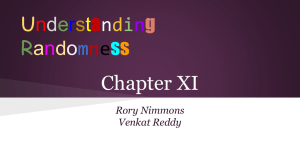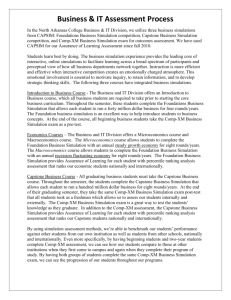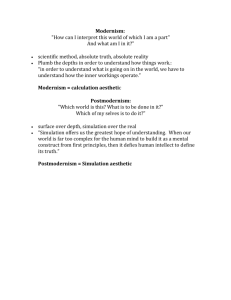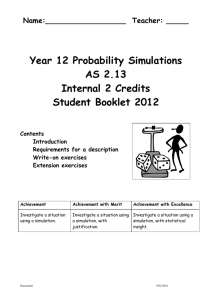Step 1: Assumptions
advertisement
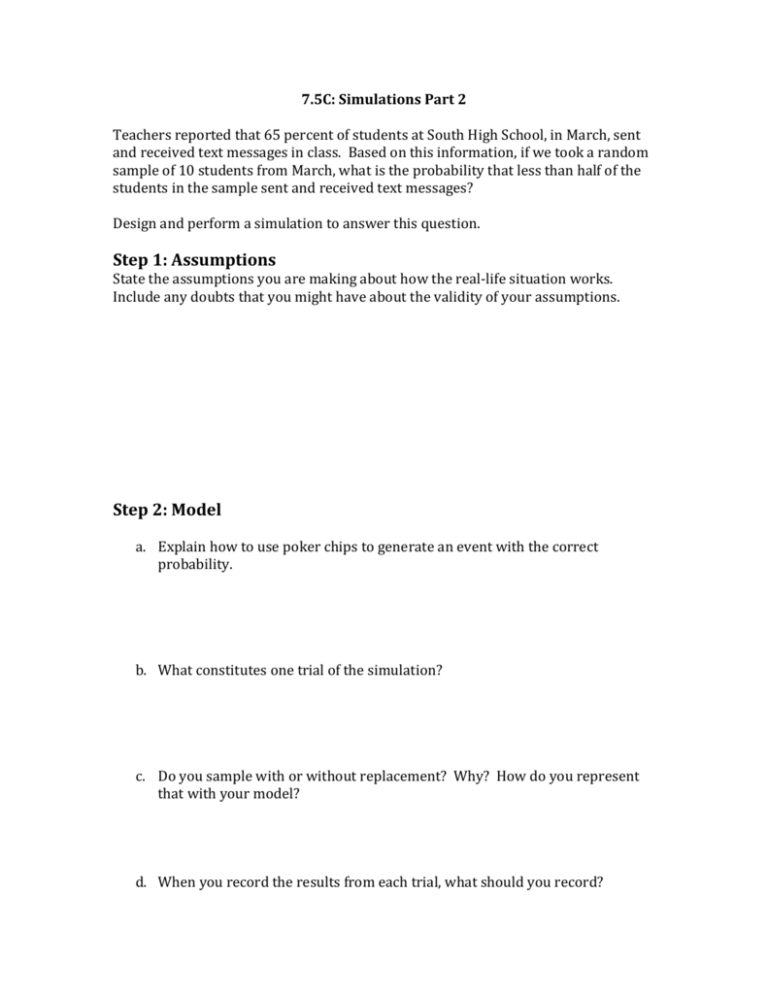
7.5C: Simulations Part 2 Teachers reported that 65 percent of students at South High School, in March, sent and received text messages in class. Based on this information, if we took a random sample of 10 students from March, what is the probability that less than half of the students in the sample sent and received text messages? Design and perform a simulation to answer this question. Step 1: Assumptions State the assumptions you are making about how the real-life situation works. Include any doubts that you might have about the validity of your assumptions. Step 2: Model a. Explain how to use poker chips to generate an event with the correct probability. b. What constitutes one trial of the simulation? c. Do you sample with or without replacement? Why? How do you represent that with your model? d. When you record the results from each trial, what should you record? Step 3: Repetition Perform 10 trials of the simulation. Trial 1: Trial 2: Trial 3: Trial 4: Trial 5: Trial 6: Trial 7: Trial 8: Trial 9: Trial 10: Step 4: Conclusion What did you learn as a result of doing this activity that you did not know before? 7.5D: Simulations Part 3 Teachers reported that 65 percent of students at South High School, in March, sent and received text messages in class. Based on this information, if we took a random sample of 10 students from March, what is the probability that less than half of the students in the sample sent and received text messages? Design and perform a simulation to answer this question. Step 1: Assumptions State the assumptions you are making about how the real-life situation works. Include any doubts that you might have about the validity of your assumptions. Step 2: Model a. Explain how to use a random digit table to generate an event with the correct probability. b. What constitutes one trial of the simulation? c. Do you sample with or without replacement? Why? How do you represent that with your model? d. When you record the results from each trial, what should you record? Step 3: Repetition Perform 10 trials of the simulation. Start at the leftmost digit in the first row of the table and move across. Show the specific results of each trial. Trial 1: Trial 2: Trial 3: Trial 4: Trial 5: Trial 6: Trial 7: Trial 8: Trial 9: Trial 10: Step 4: Conclusion Give the estimated probability, based on your total of 10 trials, that at least half of the students in a sample sent and received text messages. What did you learn as a result of doing this activity that you did not know before? 7.5B: Simulations Part 1 Teachers reported that 65 percent of students at South High School, in March, sent and received text messages in class. Based on this information, if we took a random sample of 10 students from March, what is the probability that less than half of the students in the sample sent and received text messages? Design and perform a simulation to answer this question. Step 1: Assumptions State the assumptions you are making about how the real-life situation works. Include any doubts that you might have about the validity of your assumptions. Step 2: Model a. Explain how to use a random digit generator on a graphing calculator to generate an event with the correct probability. b. What constitutes one trial of the simulation? c. When you record the results from each trial, what should you record? Step 3: Repetition Perform 10 trials of the simulation. Trial 1: Trial 2: Trial 3: Trial 4: Trial 5: Trial 6: Trial 7: Trial 8: Trial 9: Trial 10: Step 4: Conclusion What did you learn as a result of doing this activity that you did not know before?






